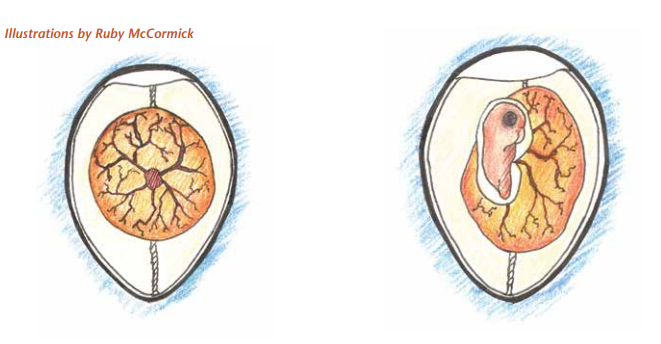Before we get started on embryonic development, let’s learn about the structure of the egg to make things easier to understand. The eggshell is composed of calcium and magnesium salts, and is porous in texture. This porosity allows water vapor and respiratory gasses to pass in and out of the shell. The “yolk” of an egg is actually the ovum, and, when fertilized, the germinal spot on the ovum develops into the embryo. The yolk is surrounded by a yolk sac, termed the vitelline membrane. This embryo is surrounded by three tissue layers, the amnion, chorion, and allantois. The amnion eventually forms the amniotic fluid that surrounds the embryo, all of which is surrounded by the amniotic membrane. The chorion and allantois layers combine, forming the chorioallantois, which acts as the respiratory and excretory systems for the embryo. To stabilize the embryo and keep it in position within the egg are two twisted strands of albumen called chalazae. These are attached to either end of the egg. At the larger end of the egg is the air sac, which allows the emerging hatchling to breathe for a short period of time. If you crack open an unfertilized chicken egg for breakfast, you can actually examine these structures for yourself.

The process of embryonic development is basically the same in all birds, with only a few exceptions. Precocial birds, such as chickens, are birds that are hatched with open eyes and a thick coat of feathers, and are able to leave the nest in a day or two. Martins are altricial birds, meaning that they hatch featherless and are unable to leave the nest. Thus, precocial birds lay larger eggs3 that take longer to hatch—21 days for chickens and only 15 for martins. There are a total of 42 stages in embryo development, with organogenesis (formation of organs) and the development of a body plan taking place in the first 33 stages. This is when the brain and digestive system are formed, the skeletal system is calcified, and feathers develop. The last few stages are more species specific, with certain stages lasting longer in some species than others1. Throughout this entire process, the embryo is nourished by the egg yolk and albumen.
In order for fertilization to occur, birds must copulate. Unlike mammals, birds do not have external genitalia. Instead, they have cloacae, common openings for both reproduction and excretion. In most birds, copulation only lasts a few seconds, in which the male bird mounts the female from behind and their cloacae touch. Sperm is transferred to the female by the “cloacal kiss.” In passerines (song birds), such as Purple Martins, males do not have a penis to transfer sperm. The sperm swim up to the ovum where fertilization occurs. Although some birds store sperm to use in the future, for most birds, one copulation is enough to fertilize all the eggs laid in one week. After fertilization, shell formation, and egg laying, there is an incubation period, which varies in length for each species. As stated previously, the incubation period for martins is 15-16 days. During incubation, major embryonic development occurs. First, the gastrointestinal track starts to form, along with the formation of the brain, head, nervous system, and eyes. The very tiny embryo turns onto its left side and blood vessels can be seen in the yolk sac. Veins start to form, as does the heart, which starts beating soon after. Ear pits develop as does the amnion (the membranous sac that protects the embryo) and the throat. For the chicken, the most common example given, this all occurs during the first and second days of incubation.
Next is the formation of the wings, nose, tongue, and legs. At this point, the amniotic sac completely surrounds the embryo. The allantois is another sac-like structure that is involved in respiration and secretion of wastes, and is also formed at this stage. Next, the gizzard and sex organs develop. The beak and egg-tooth start to form, and legs and wings become more defined. Voluntary movement begins. In precocial birds, feather formation begins at this stage. After this, the mouth opening starts to appear, toes are fully formed, and the beak starts to harden.

Before hatching, the embryo turns so its head is at the blunt end of the egg. The small intestines, which have been outside the body, are now taken into the body. The beak, with the newly formed egg-tooth breaks though the amnion into the air sac, where the young first breathes on its own. However, the air supply is limited so the hatchling must break through the rest of the shell soon. Finally, the bird hatches!
Read the original publication written by Emily K. Pifer HERE.
